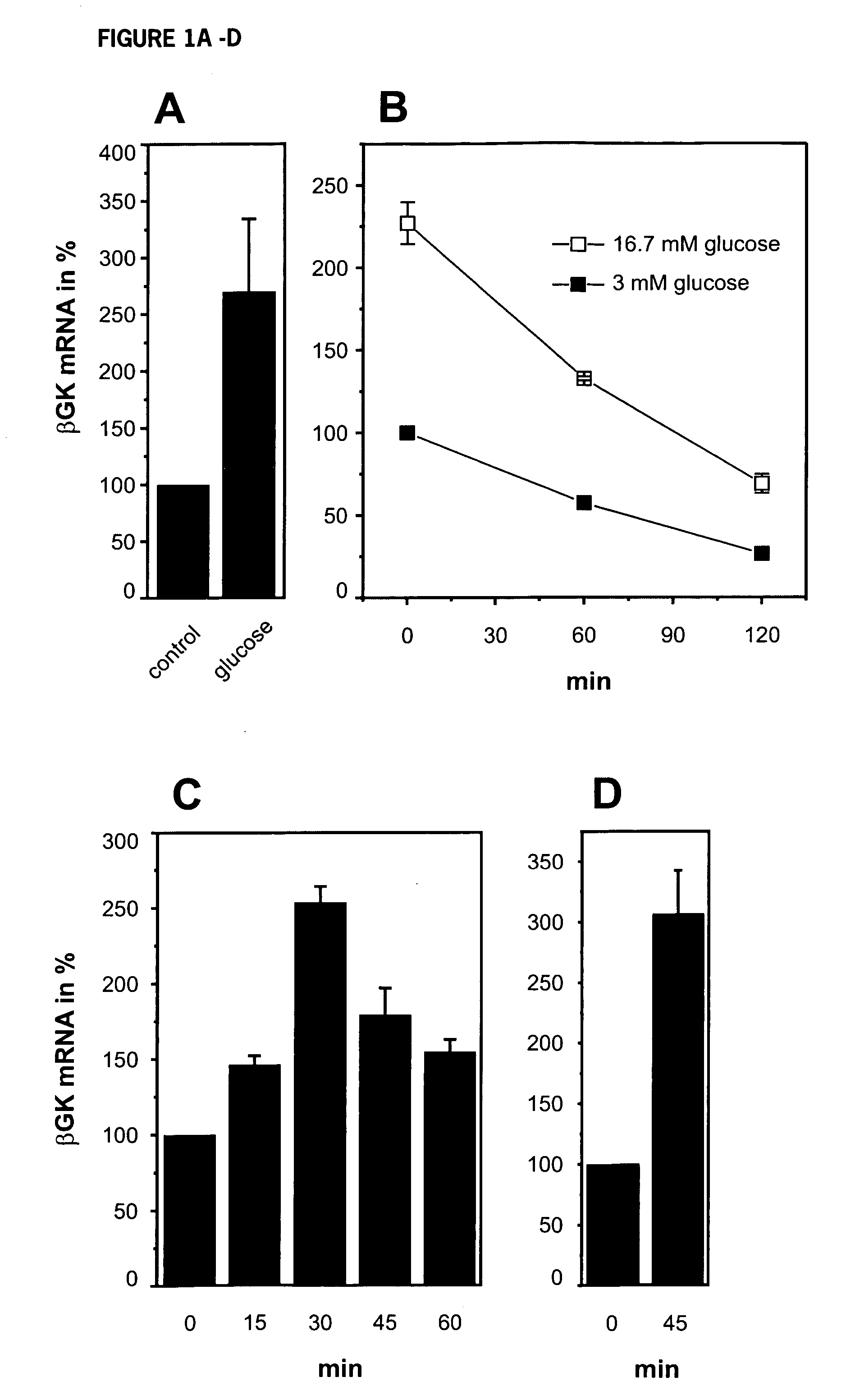Novel mechanism for identifying drugs for the treatment of type II diabetes
a type ii diabetes and drug technology, applied in the field of new mechanism for identifying drugs for the treatment of type ii diabetes, can solve the problems of tissue-based and development-dependent effects of insulin
- Summary
- Abstract
- Description
- Claims
- Application Information
AI Technical Summary
Benefits of technology
Problems solved by technology
Method used
Image
Examples
example 1
Glucose activates glucokinase gene transcription via secreted insulin
[0155] Insulin, secreted upon glucose-stimulation, is a key factor in the up-regulation of insulin gene transcription (Leibiger et al. 1998a). The promoters of both the insulin gene and the βGK gene contain many similar cis-acting elements (Watada et al., 1996). To test whether transcription of βGK is regulated by similar mechanisms as the insulin gene, the role of glucose and insulin in regulation of βGK mRNA steady-state levels was investigated. Stimulation of cultured islets (FIG. 1A) or insulin-producing HIT-T15 cells with 16.7 mM glucose led to an increase in βGK mRNA levels 60 min following start of stimulation. This is similar in time course to the effect of glucose to stimulate insulin mRNA levels (Leibiger et al., 1998a, 1998b).
[0156] To define in more detail the dynamics of βGK mRNA, the half-life time, stability and transcriptional rate of the βGK mRNA pool was analyzed. As shown in FIG. 1B, the half-...
example 2
Insulin-stimulated glucokinase gene transcription utilizes signal transduction, which is different from that of the insulin gene—protein kinases
[0160] The careful studies of the present inventors on insulin-stimulated insulin gene transcription showed the involvement of phosphatidylinositol-3 kinase, p70 s6 kinase and Ca2+ / calmodulin dependent kinase(s) in the signaling cascade (Leibiger et al., 1998a). Previous data suggested that insulin- and βGK-promoters could bind the same transcription factors (Watada et al., 1996; Leibiger et al., 1994a, 1994b) and both genes did respond positively to many of the same stimuli (glucose, insulin, secretagogues) at the level of transcription, it was questioned whether both genes might be regulated by the same signaling pathway.
[0161] To test whether the same protein kinases that are involved in insulin-triggered insulin-gene transcription contribute to insulin-triggered transcription of βGK, the effect of pharmacological inhibitors on insulin...
example 3
Insulin signaling via A type Insulin Receptor activates insulin gene promoter whereas signaling via B type Insulin Receptor activates βGK promoter
[0165] Previous data on insulin-stimulated insulin gene transcription (Leibiger et al., 1998a) favored signaling via Insulin Receptors but did not exclude the signaling via IGF-I receptors or possible hybrids of insulin and IGF-I receptors. The loss of insulin-effect, when treating cells with HNMPA-(AM)3, an inhibitor of the Insulin Receptor tyrosine kinase, supported the idea that signaling via Insulin Receptors is crucial. Consequently, it was examined whether the expression of Insulin Receptors per se is an absolute requirement for insulin-stimulated insulin gene and βGK gene expression. Therefore, insulin and βGK mRNA levels were analyzed in response to glucose / insulin stimulation in isolated islets from βIRKO mice, a knock-out model that lacks the expression of Insulin Receptors, specifically in the pancreatic beta cell (Kulkarni et...
PUM
| Property | Measurement | Unit |
|---|---|---|
| Electrical resistance | aaaaa | aaaaa |
| Gene expression profile | aaaaa | aaaaa |
| Fluorescence | aaaaa | aaaaa |
Abstract
Description
Claims
Application Information
 Login to View More
Login to View More - R&D Engineer
- R&D Manager
- IP Professional
- Industry Leading Data Capabilities
- Powerful AI technology
- Patent DNA Extraction
Browse by: Latest US Patents, China's latest patents, Technical Efficacy Thesaurus, Application Domain, Technology Topic, Popular Technical Reports.
© 2024 PatSnap. All rights reserved.Legal|Privacy policy|Modern Slavery Act Transparency Statement|Sitemap|About US| Contact US: help@patsnap.com










